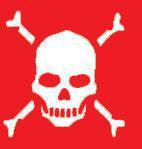SAS Urban Survival Handbook (34 page)
Read SAS Urban Survival Handbook Online
Authors: John Wiseman
Tags: #Health & Fitness, #Reference, #Survival, #Fiction, #Safety, #Self-Help, #Personal & Practical Guides, #General, #Survival Skills

Wear gloves and cover up other parts of your body as protection from splashes. Safety glasses should also be considered when painting ceilings or using a roller.
If you get ANY paint in your eyes, wash them with cool running water for at least ten minutes, holding the lids open. Either hold your head under a fairly low-pressure flow from a shower hose or put your head under a tap. If neither of these is possible, splash the eye for several minutes with water from a bowl. If there is any soreness, seek medical attention.
Paint spraying
There are two main types of spray equipment, which you may not choose to own, but which are readily available from hire shops. One involves an air compressor, which forces out paint droplets in a jet of air. The other forces the paint itself out under great pressure.
AVOID breathing paint mist or fumes—wear goggles and a very efficient face mask. Cover as much skin as possible. Ensure very good ventilation. Do NOT spray indoors, if possible. If you must, open doors and windows to let the air circulate. An extractor fan would be a good idea.
There is a high risk of fire and explosion—do NOT smoke or use naked flames PARTICULARLY if using oil/solvent-based paints.

WARNING
NEVER leave equipment where a child could get at it. NEVER aim the gun at any part of your body—or at anyone else. The paint in ‘airless’ guns is sprayed at such a pressure that it can penetrate skin and surface tissues. NEVER touch the nozzle while paint is being sprayed—on either sort of equipment. If there is a safety shield, do NOT remove it.
If you inject paint under the skin, seek medical attention at once. Explain the injury and supply all known details about the paint involved. Disconnect the machine from the mains before attempting to clear a blocked nozzle.
Aerosol cans of paint are also to be used with extreme caution—even when just doing small touch-up jobs on your car. Always wear gloves and a mask—and make sure that you don’t work in a confined space.
PRIMERS/ SPECIAL PAINTS
The only exception to the ‘no-lead-in-paint’ rule is calcium plumbate primer – no efficient alternative has been found for galvanized metal. Remember that lead is highly toxic and take great precautions to avoid exposing yourself to this risk. Never use calcium plumbate primer indoors. Avoid hand-to-mouth contact (don’t smoke, eat or drink while using). Wear a mask and cover all skin. Don’t breathe the fumes. If a large area of painting must be done, seek professional advice.
Many special primers contain aluminium or zinc – both of which are toxic in concentration – ut are safer than any primer containing lead.
Bitumen paints for roofs and external metalwork, and creosote (commonly used as a preservative on fences and outbuildings) are poisonous. Skin contact and inhalation of the fumes should be avoided. Dermatitis (slight to severe skin irritation) is fairly certain and links are being investigated between coal tar derivatives and cancer. Two constituents are known carcinogens – chrysene and benzo-a-pyrene.

WARNING
If a child swallows any paint, do not induce vomiting—especially with oil/solvent-based paints. If the child has swallowed emulsion paint (without fungicide) give them a glass of water to drink slowly. See how the child feels after half an hour. If the child has swallowed a small amount of paint containing fungicide or a large amount of any emulsion paint, seek medical attention. If any amount of oil/solvent-based paints is swallowed, seek medical attention.
Stripping paint
Stripping paint used to be a chore. Now it is a booming industry and even a major hobby—although the ‘stripper’ tends to find out pretty quickly that it is basically still a chore! Large jobs tend to get messier and messier and more and more boring—and people get careless, trying to get the job finished.
If you have decided to become a ‘stripper’, you have two main alternatives: to heat the paint with a blow-torch (or blowlamp) or hot-air stripper and scrape it away, or to use a paintdissolving chemical stripper. Both have many hazards.
The likelihood, if you want a plain wooden finish, is that—having used heat—you will need a chemical stripper to clean the remains of the paint from the wood. If you are repainting, sanding would probably be adequate.
A hot-air stripper is more controllable than a blow-torch but don’t underestimate the heat it can produce.
Hot-air strippers
Heating only really works with ‘gloss’ or oil-based paints—not on cellulose (car) paints or emulsion paints. It is only really suitable for wood—not metal or plastic. You have to heat the paint until it bubbles (not burns) and scrape it off fairly rapidly before it goes hard and ‘cooks’.
A hot-air stripper is fairly easy to use. It works (basically) like a super-powered hairdryer—but is also quite dangerous. No hot stripping is easy near glass—the glass will break—and special shields must be used. A variable heat control on a hot-air stripper would give you more control. Whichever method you use, keep the heat source moving to prevent burning.
Keep a special clear area for ‘resting’ the hot lamp/torch/ stripper when you are not using it. Keep some water handy in case a fire starts. Work in a well-ventilated area (see WARNING above right) and wear a mask and goggles. Don’t wear rubber or plastic gloves which may melt onto the skin.
If working outdoors, stop if conditions become windy—the heat would not be directable. Avoid cracks and crevices around door and window frames and working under the eaves of your house—a fire may start very easily. It may be very difficult to reach it to put it out. As the debris falls it is smouldering—damp it down every few minutes with a water spray.
Clearing up
DON’T run a bare hand over a partially-stripped area or collect debris without gloves. Some of the fragments, when cooled and hardened, can be razor sharp. Wear breathing protection and gloves. Dispose of all debris carefully. Don’t burn it—more fumes will be given off.

WARNING
Older paints are very likely to contain lead, which is extremely toxic. Do not breathe fumes. Wear eye and breathing protection and keep skin covered up.
Old textured paint—even only a few years old—may contain asbestos, which is highly dangerous if inhaled. Special chemical strippers claim to be safe for the job, but seek professional advice before tackling removal.
Chemical strippers
There are several kinds of chemical stripper—most are messy, all are poisonous and will burn the skin quite badly. Most produce fumes which are toxic, and make you feel dizzy or nauseous.
It’s basically a question of applying the stripper, leaving it a while to do its job and scraping it off again. This often has to be done several times to completely remove all paint. If you wait too long, the solvent (or moisture, in some types) evaporates and the job becomes much harder.
Good ventilation is ESSENTIAL—as are eye/breathing/ hand protection. Thick plastic gloves are fine, but will gradually dissolve. If they start to leak, replace them. Cover up as much skin as possible and try to work in a very controlled way—DON’T slosh the stuff about.
If any chemical touches your skin, wash it off with water at once. If you don’t, you will very quickly feel what the chemical can do. Very painful burns are possible. If ANY of the chemical goes in your eyes, flush with cool running water for at least ten minutes—with the lids held open. Seek medical attention.
Paste strippers, which you mix with water, often come in powder form. DO NOT INHALE! Wear a mask when mixing. These strippers are usually based on caustic soda (sodium hydroxide) which will dissolve skin very efficiently.
The grain of the wood may ‘lift’ with water-based paste strippers and ‘water-washable’ liquid strippers if water is used as a final rinse. When sanding, avoid the dust which will contain residual chemicals. Cover your skin, and wear gloves, a mask and goggles.
There are aerosol liquid strippers which—even if discontinued—may still be found on some dealers’ shelves. Somehow, the idea of spraying a highly toxic, highly caustic substance does not seem safe or intelligent.
If you don’t have a lot of energy or patience—DON’T attempt the large-scale removal of paint. Call a specialist!
CRAFTS
 There are a number of crafts that are enjoyed at home, sometimes as business ventures – many involve dangerous tools, processes, materials and chemicals that require careful handling and storage. Businesses must meet legal standards of workplace safety. The same precautions are VITAL at home.
There are a number of crafts that are enjoyed at home, sometimes as business ventures – many involve dangerous tools, processes, materials and chemicals that require careful handling and storage. Businesses must meet legal standards of workplace safety. The same precautions are VITAL at home.
CHILDPROOFING
Instruct children in the dangers of crafts processes and materials. Exclude them from the work area, if possible securing and locking it when not in use, lest they attempt to ‘have a go’ themselves.
Photography
Keen photographers will probably want to do their own processing and printing. If you use the bathroom as a darkroom make sure that you always clear everything away afterwards. If you have a proper darkroom make it lockable. The deeper you get into processing the more chemicals you will need.
Experiment with different types of tongs and plastic gloves to find the best way of avoiding contact with chemicals. Barrier creams may leave fingerprints on film or paper.
- ◑ NEVER be casual about mixing or storing chemicals.
- ◑ AVOID skin contact with any chemical—even if you think it is harmless. Once you start putting your fingers in the baths for developer, stop and fix, you will find it very difficult to get out of the habit. You may suffer from dermatitis straight away or develop sensitivity later on.
- ◑ AVOID inhaling chemical powder, which is easily carried in the air. This is when chemicals are at their strongest. Wear a face mask. Fit an extractor fan.
- ◑ AVOID hand-to-mouth contact. Don’t smoke, eat or drink in the darkroom.
- ◑ NEVER raise bottles to your face to sniff the contents. The smell of some chemicals will knock you over—especially concentrated acetic acid ‘stop’ solution.
- ◑ DON’T empty any chemicals down the sink. Contact the manufacturer or dealer regarding safe disposal.
- ◑ REMEMBER you are working with a potentially fatal combination of electricity and water.
